Effect of UV Radiation on Structural Damage and Tribological Properties of Mo/MoS2-Pb-PbS Composite Films
Abstract
:1. Introduction
2. Experimental Details
2.1. Materials and Equipment
2.2. Process
3. Results and Discussion
3.1. Structure and Tribological Properties
3.2. Damage Mechanism
4. Conclusions
Author Contributions
Funding
Institutional Review Board Statement
Informed Consent Statement
Data Availability Statement
Conflicts of Interest
References
- Zhang, Z.; Liu, W.; Xue, Q.; Zen, J. Current state of tribological application and research of Mo compounds as lubricating materials. Tribology 1998, 18, 377–382. [Google Scholar]
- Cizaire, L.; Vacher, B.; Le Mogne, T.; Martin, J.M.; Rapoport, L.; Margolin, A.; Tenne, R. Mechanisms of ultra-low friction by hollow inorganic fullerene-like MoS2 nanoparticles. Surf. Coat. Technol. 2002, 160, 282–287. [Google Scholar] [CrossRef]
- Curry, J.F.; Wilson, M.A.; Luftman, H.S.; Strandwitz, N.C.; Argibay, N.; Chandross, M.; Sidebottom, M.A.; Krick, B.A. Impact of microstructure on MoS2 oxidation and friction. ACS Appl. Mater. Interfaces 2017, 9, 28019–28026. [Google Scholar] [CrossRef] [PubMed]
- Diffey, B.L. Sources and measurement of ultraviolet radiation. Methods 2002, 28, 4–13. [Google Scholar] [CrossRef] [Green Version]
- Tagawa, M.; Yokota, K.; Matsumoto, K.; Suzuki, M.; Teraoka, Y.; Kitamura, A.; Belin, M.; Fontaine, J.; Martin, J.M. Space environmental effects on MoS2 and diamond-like carbon lubricating films: Atomicoxygen-induced erosion and its effect ontribological properties. Surf. Coat. Technol. 2007, 202, 1003–1010. [Google Scholar] [CrossRef]
- Liu, W.M.; Weng, L.J.; Sun, J.Y. Handbook of Space Lubricating Materials and Technology; China Science Press: Beijing, China, 2009; pp. 156–157. [Google Scholar]
- Yan, K.; Cao, J.; Yao, W.; Yan, J.; Li, Z.; Zhu, Y. Influence of Mult-i Field Coupling on Interface Structures of Au/Cu/Si in Vacuum. Chin. J. Vac. Sci. Technol. 2013, 33, 766–770. [Google Scholar]
- Li, Y.; Zhou, H.; Chen, J. Effects of Vacuum-ultraviolet Radiation on the Tribological Properties of SiO2/MoS2/Phenolic-Epoxy Coatings. Mater. Rep. 2009, 23, 30–32+50. [Google Scholar]
- Jiang, C.; Li, Q.; Huang, J.; Bi, S.; Ji, R.; Guo, Q. Single-Layer MoS2 Mechanical Resonant Piezo-Sensors with High Mass Sensitivity. ACS Appl. Mater. Interfaces 2020, 12, 41991–41998. [Google Scholar] [CrossRef] [PubMed]
- Jamdagni, P.; Thakur, A.; Kumar, A.; Ahluwalia, P.K.; Pandey, R. Two dimensional allotropes of arsenene with a wide range of high and anisotropic carrier mobility. Phys. Chem. Chem. Phys. PCCP 2018, 20, 29939–29950. [Google Scholar] [CrossRef] [PubMed] [Green Version]
- McMorrow, J.J.; Cress, C.D.; Arnold, H.N.; Sangwan, V.K.; Jariwala, D.; Schmucker, S.W.; Marks, T.J.; Hersam, M.C. Vacuum ultraviolet radiation effects on two-dimensional MoS2 field-effect transistors. Appl. Phys. Lett. 2017, 110, 1–5. [Google Scholar] [CrossRef]
- Ma, G.; Xu, B.; Wang, H.; Cheng, S.; Xing, Z. Excellent solid lubrication properties of PbS film in vacuum deposited by sputtering and sulfurizing. ACS Appl. Mater. Interfaces 2014, 6, 532–538. [Google Scholar]
- Ma, G.; Xu, B.; Wang, H. Development of a novel multifunctional vacuum tribometer. Chin. J. Vac. Sci. Technol. 2012, 32, 1–6. [Google Scholar]
- Cuihong, H.; Guolu, L.; Guozheng, M.; Jiadong, S.; Yunfan, L.; Zhen, L.; Haidou, W. Preparation and Tribological Properties of Mo/MoS2-Pb-PbS Composite Films. Surf. Coat. Technol. 2021, 405, 126625. [Google Scholar] [CrossRef]
- Zhigang, S.; Xiaohu, Z.; Yushan, S.; Shulin, M. Experimental investigations of the respective and synergistic effects of vacuum ultraviolet radiation and atomic oxygen on a spacecraft material-Kapton. J. Beijing Univ. Aeronaut. Astronaut. 2003, 29, 984–987. [Google Scholar]
- Dever, J.A. Low Earth Orbital Atomic Oxygen and Ultraviolet Radiation Effects on Polymers; N91-12594; National Aeronautics and Space Administration: Washington, DC, USA, 1991.
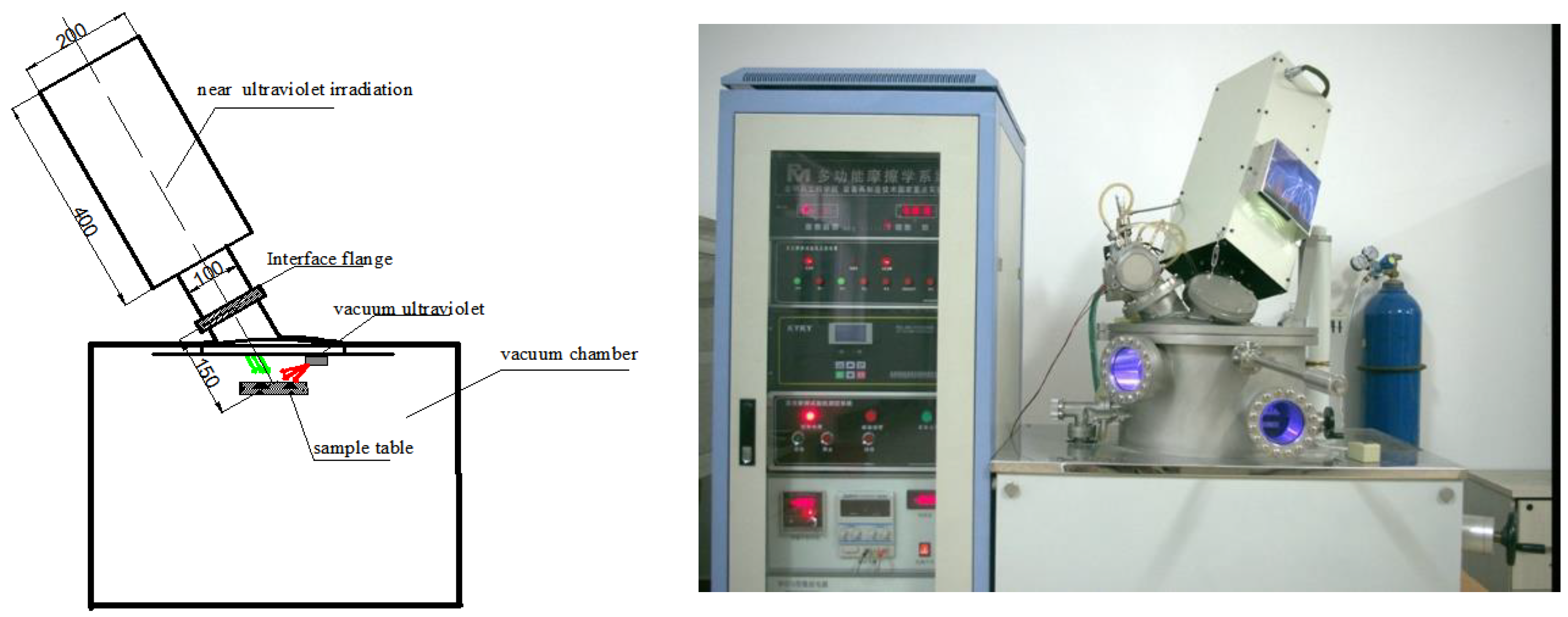

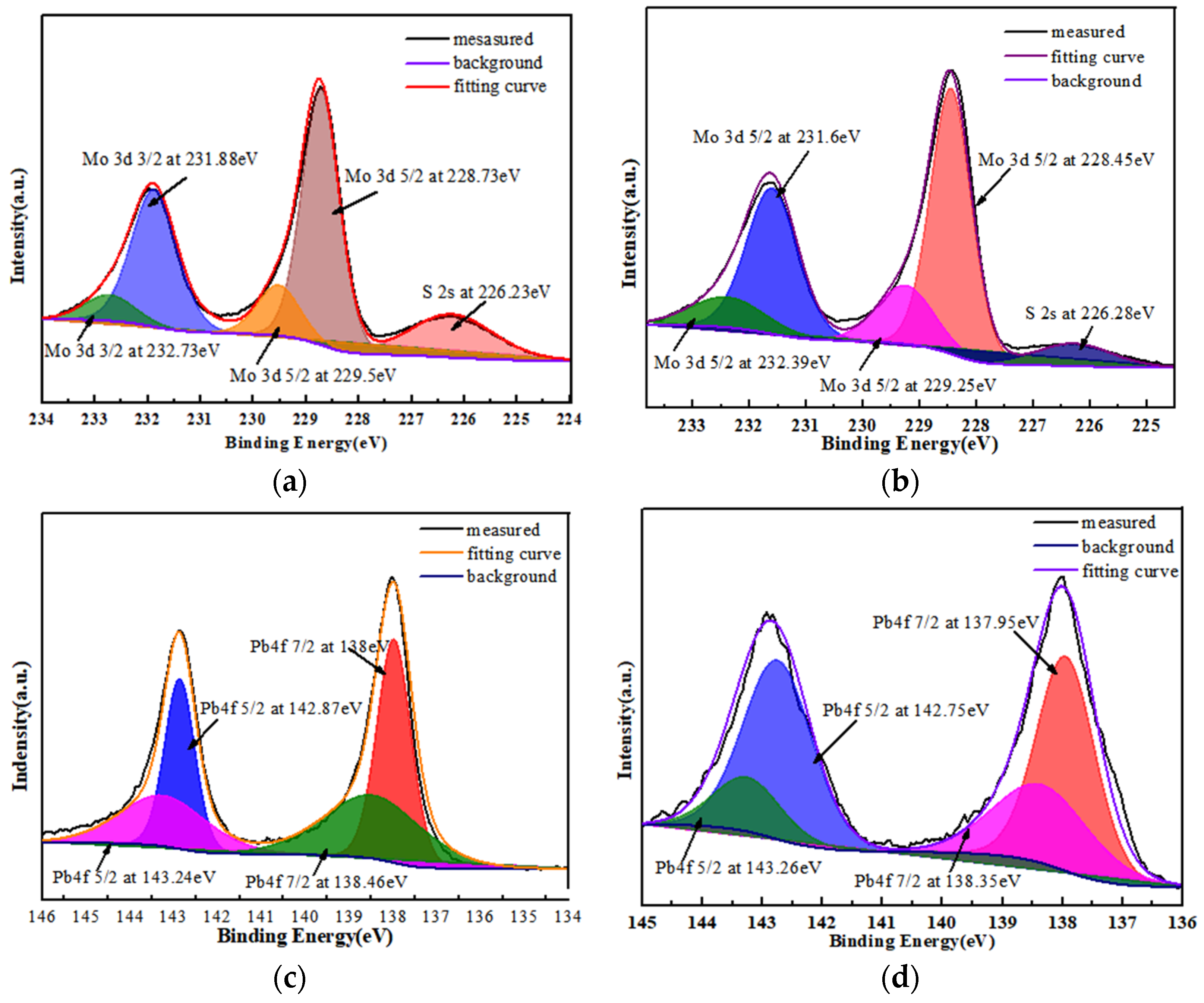
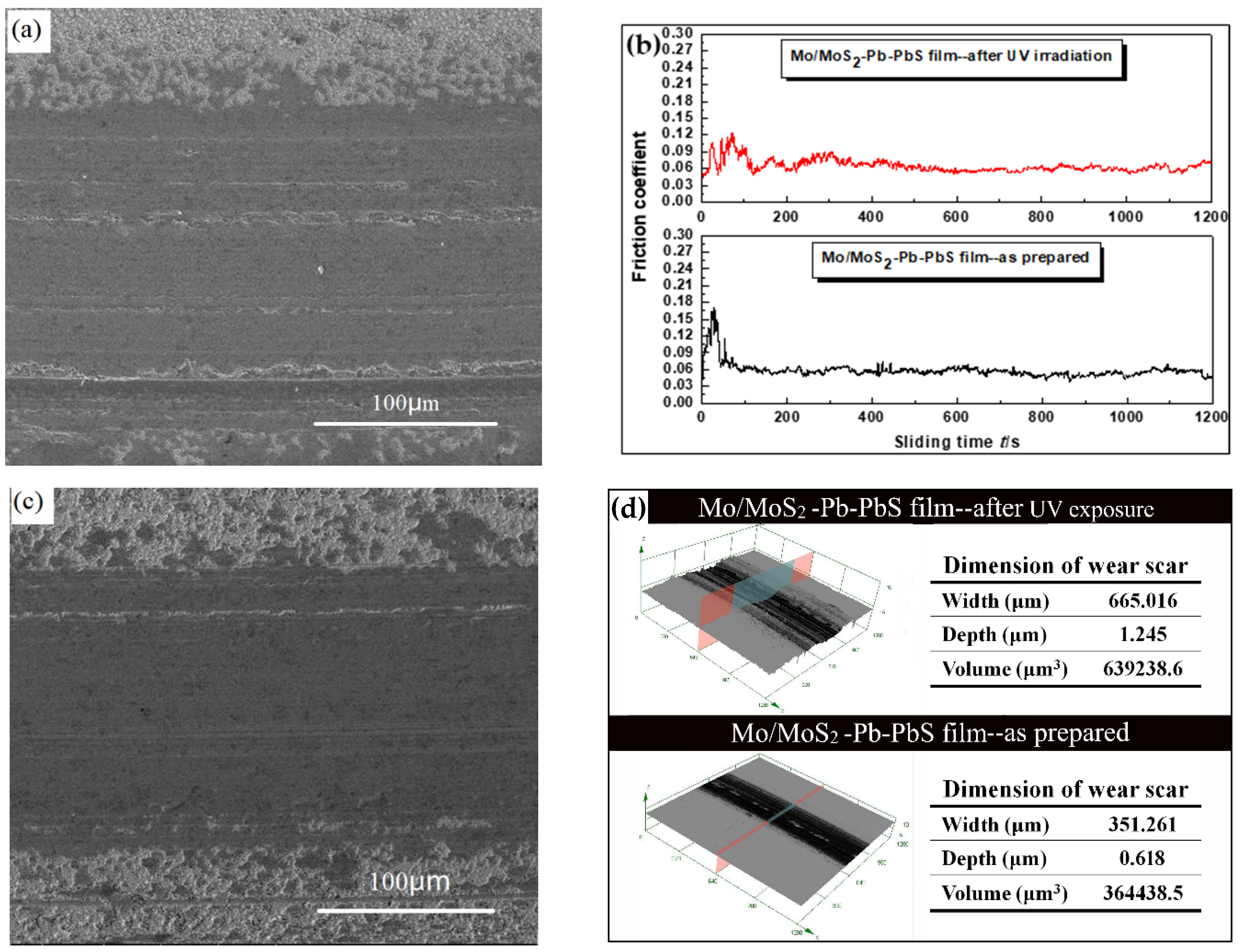
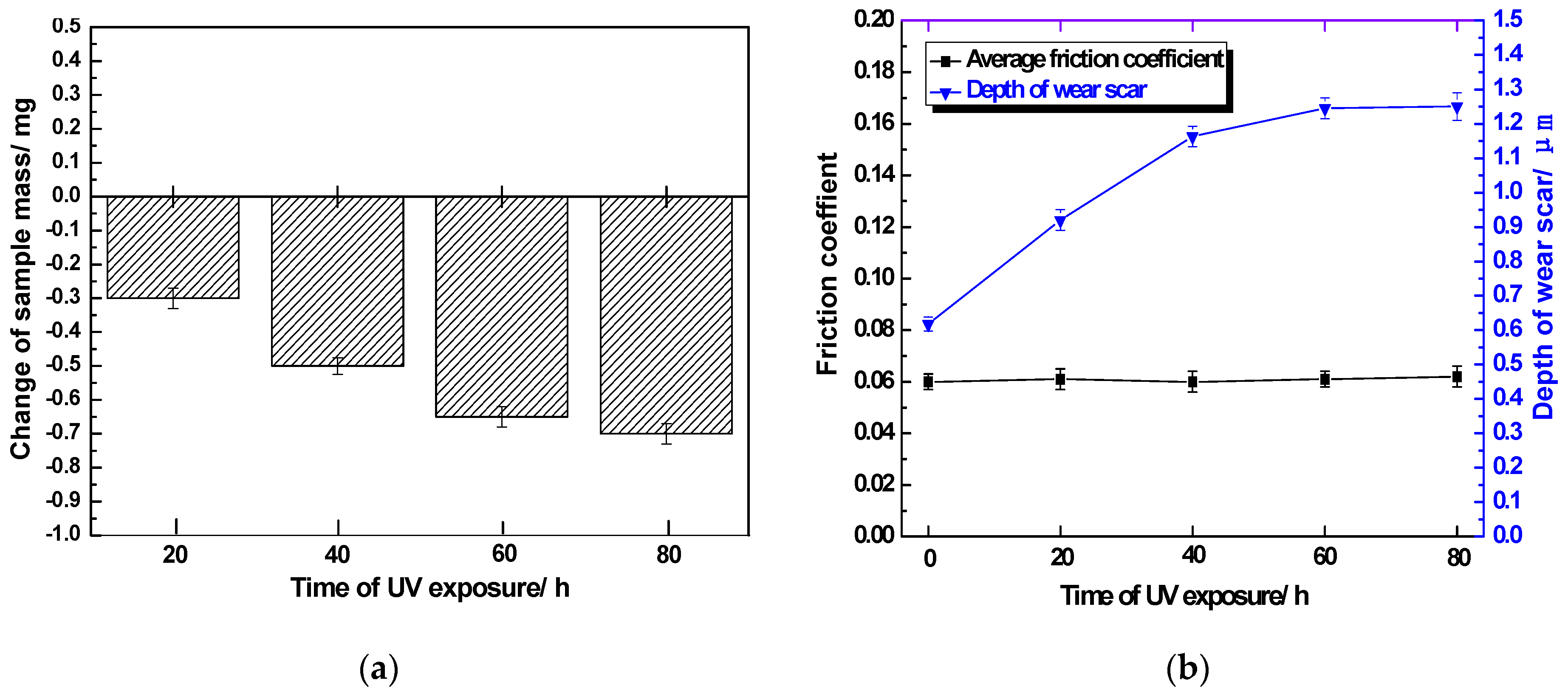
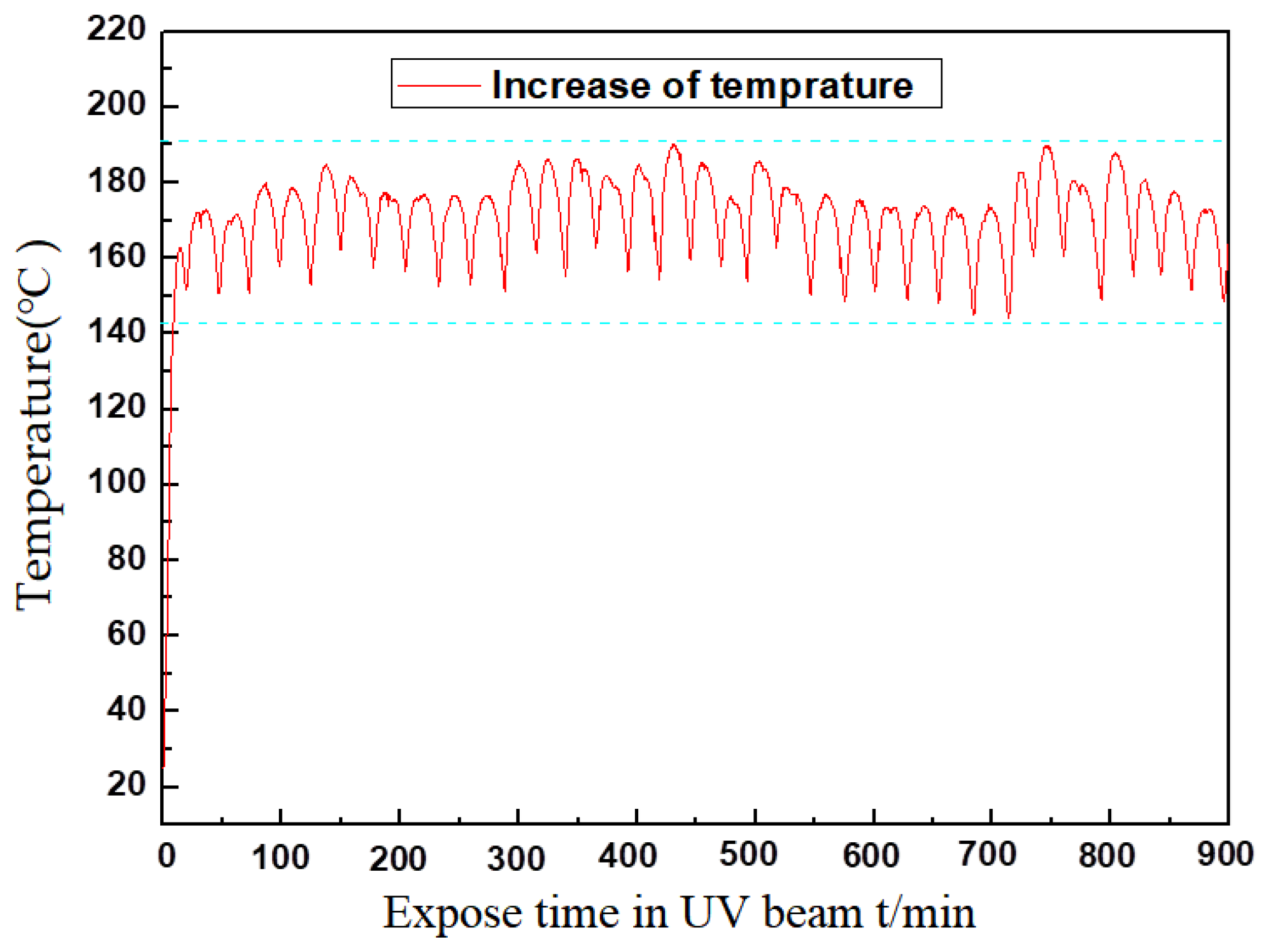
| Parameter | Value | Parameter | Value | Parameter | Value |
|---|---|---|---|---|---|
| UV radiation intensity | >3 UV constants | spectral range | 120–400 nm | radiation area | >Φ50 mm |
| collimation angle | <5° | UV radiation uniformity | >±10% | stability | >5%/h |
Publisher’s Note: MDPI stays neutral with regard to jurisdictional claims in published maps and institutional affiliations. |
© 2022 by the authors. Licensee MDPI, Basel, Switzerland. This article is an open access article distributed under the terms and conditions of the Creative Commons Attribution (CC BY) license (https://creativecommons.org/licenses/by/4.0/).
Share and Cite
Han, C.; Li, G.; Ma, G.; Shi, J.; Li, Z.; Yong, Q.; Wang, H. Effect of UV Radiation on Structural Damage and Tribological Properties of Mo/MoS2-Pb-PbS Composite Films. Coatings 2022, 12, 100. https://doi.org/10.3390/coatings12010100
Han C, Li G, Ma G, Shi J, Li Z, Yong Q, Wang H. Effect of UV Radiation on Structural Damage and Tribological Properties of Mo/MoS2-Pb-PbS Composite Films. Coatings. 2022; 12(1):100. https://doi.org/10.3390/coatings12010100
Chicago/Turabian StyleHan, Cuihong, Guolu Li, Guozheng Ma, Jiadong Shi, Zhen Li, Qingsong Yong, and Haidou Wang. 2022. "Effect of UV Radiation on Structural Damage and Tribological Properties of Mo/MoS2-Pb-PbS Composite Films" Coatings 12, no. 1: 100. https://doi.org/10.3390/coatings12010100
APA StyleHan, C., Li, G., Ma, G., Shi, J., Li, Z., Yong, Q., & Wang, H. (2022). Effect of UV Radiation on Structural Damage and Tribological Properties of Mo/MoS2-Pb-PbS Composite Films. Coatings, 12(1), 100. https://doi.org/10.3390/coatings12010100





